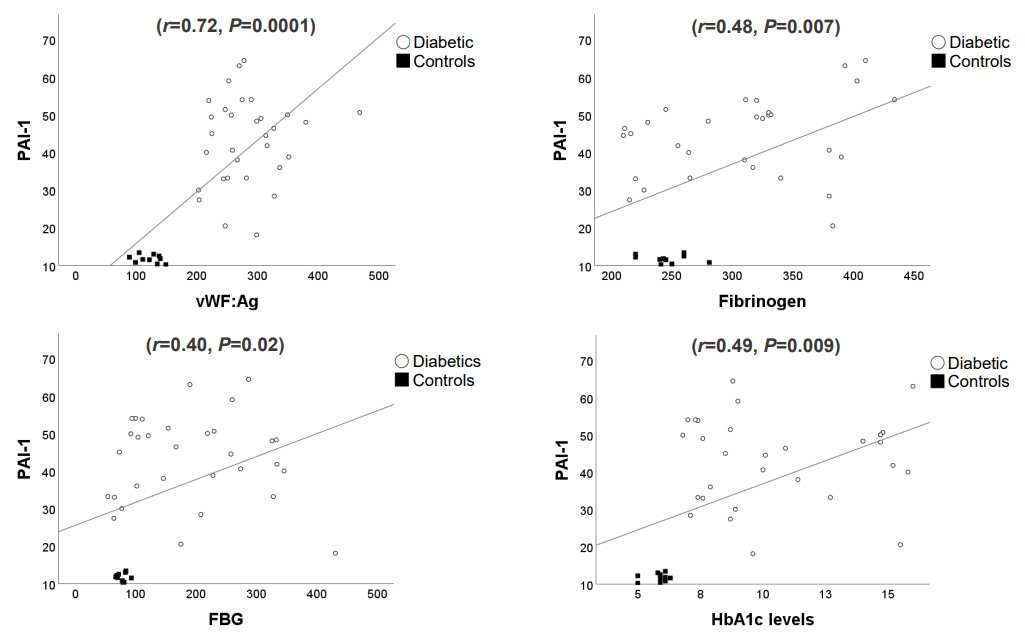 |
 |
- Search
| Ann Pediatr Endocrinol Metab > Volume 26(2); 2021 > Article |
|
Abstract
Purpose
Methods
Results
Notes
ACKNOWLEDGMENTS
Fig. 1.

Table 1.
| Characteristic | Diabetic (n=35) | Control (n=20) | P-value |
|---|---|---|---|
| Sex, male:female (n) | 20:15 | 13:7 | 0.567 |
| Age (yr), median (IQR) | 11 (10–13) | 10 (9–12) | 0.137 |
| BMI (kg/m2) | 19.4±4.0 | 18.7±1.5 | 0.630 |
| Diabetes evolution (yr) | 3.7±2.0 | - | - |
| FBG (mg/dL) | 210±109 | 77±8 | 0.0001* |
| HbA1c (%) | 10.4±3.0 | 5.8±0.4 | 0.0001* |
| TC (mg/dL) | 167±39 | 156±28 | 0.414 |
| HDL-C (mg/dL) | 45±12 | 42±8 | 0.471 |
| LDL-C (mg/dL) | 107±39 | 99±30 | 0.569 |
| Triglyceride (mg/dL) | 90±48 | 87±16 | 0.788 |
| PT (%) | 86±15 | 90±9 | 0.468 |
| aPTT (seg) | 45±6 | 42±5 | 0.163 |
| Platelet count (×103/μL) | 286±37 | 209±50 | 0.539 |
| Fibrinogen (mg/dL) | 308±66 | 246±18 | 0.0001* |
| PAI-1 (ng/mL) | 41.6±12.0 | 11.7±1.0 | 0.0001* |
| vWF:Ag (%) | 284±55 | 121±19 | 0.0001* |
Values are presented as mean±standard deviation unless otherwise indicated.
IQR, interquartile range; BMI, body mass index; FBG, fasting blood glucose; HbA1c, glycosylated hemoglobin A1c; TC, total cholesterol; HDL-C, high-density lipoprotein cholesterol; LDL-C, low-density lipoprotein cholesterol; PT, prothrombin time; aPTT, activated partial thromboplastin time; PAI-1, plasminogen activator inhibitor-1; vWF:Ag, Von Willebrand Factor:Antigen.
Table 2.
| Variable | GGC (n=9) | PGC (n=26) | P-value |
|---|---|---|---|
| FBG (mg/dL) | 123.13±62.51 | 253.44±102.96 | 0.004* |
| HbA1c (%) | 7.2±0.3 | 11.5±2.7 | 0.0001* |
| PT (%) | 88±8 | 84±18 | 0.636 |
| aPTT (sec) | 45±3 | 46±8 | 0.619 |
| Platelet count (×103/μL) | 274±47 | 290±36 | 0.492 |
| Fibrinogen (mg/dL) | 341±64 | 290±63 | 0.056 |
| PAI-1 (ng/mL) | 43.8±12.1 | 40.4±13.3 | 0.545 |
| vWF:Ag (%) | 272±39 | 288±58 | 0.630 |
Values are presented as mean±standard deviation.
GGC, good glucemic control (HbA1c≤8%); PGC, poor glucemic control (HbA1c>8%). FBG, fasting blood glucose; HbA1c, glycosylated hemoglobin A1c; PT, prothrombin time; aPTT, activated partial thromboplastin time; PAI-1, plasminogen activator inhibitor-1; vWF:Ag: Von Willebrand Factor:Antigen.
Table 3.
References
- TOOLS
- Related articles in APEM
-
Islet cell transplantation transitioning to proven therapy for type 1 diabetes2021 June;26(2)
Commentary on "Haemostatic state in children with type 1 diabetes"2021 June;26(2)
Thyroid imaging study in children with suspected thyroid dysgenesis2021 March;26(1)
Cardiac autonomic neuropathy in nonobese young adults with type 1 diabetes2019 September;24(3)







